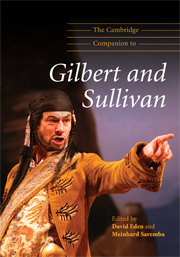Book contents
- Frontmatter
- Part I Background
- Part II Focus
- 5 The operas in context: stylistic elements – the Savoy and beyond
- 6 The librettos in context: Gilbert's ‘fables in song’
- 7 ‘This particularly rapid, unintelligible patter’: patter songs and the word–music relationship
- 8 Standing still and moving forward: The Mikado, Haddon Hall and concepts of time in the Savoy operas
- 9 Musical contexts I: motives and methods in Sullivan's allusions
- 10 Musical contexts II: characterisation and emotion in the Savoy operas
- Part III Reception
- Part IV Into the twenty-first century
- Appendix 1 Who wrote the overtures?
- Appendix 2 Stage and choral works by Arthur Sullivan and W. S. Gilbert
- Appendix 3 Modern editions of works by Arthur Sullivan and W. S. Gilbert
- Appendix 4 Sullivan's archetypes of English opera
- Notes
- Bibliography and further reading
- Index
- Plate section
10 - Musical contexts II: characterisation and emotion in the Savoy operas
from Part II - Focus
Published online by Cambridge University Press: 28 September 2011
- Frontmatter
- Part I Background
- Part II Focus
- 5 The operas in context: stylistic elements – the Savoy and beyond
- 6 The librettos in context: Gilbert's ‘fables in song’
- 7 ‘This particularly rapid, unintelligible patter’: patter songs and the word–music relationship
- 8 Standing still and moving forward: The Mikado, Haddon Hall and concepts of time in the Savoy operas
- 9 Musical contexts I: motives and methods in Sullivan's allusions
- 10 Musical contexts II: characterisation and emotion in the Savoy operas
- Part III Reception
- Part IV Into the twenty-first century
- Appendix 1 Who wrote the overtures?
- Appendix 2 Stage and choral works by Arthur Sullivan and W. S. Gilbert
- Appendix 3 Modern editions of works by Arthur Sullivan and W. S. Gilbert
- Appendix 4 Sullivan's archetypes of English opera
- Notes
- Bibliography and further reading
- Index
- Plate section
Summary
A proper understanding of Sullivan's creative stance is central to any discussion of the musical contribution to the Savoy operas. During the course of an interview given to the San Francisco Daily Chronicle in 1885 he made what amounts to a ‘mission statement’ regarding his approach to composition for the stage. ‘I adhere’, he said, ‘to the principles of art which I had learned in the production of more solid works, and no musician who analyses the score of those light operas will fail to find the evidence of seriousness and solidity pointed out’.
The use of the word ‘serious’ does not mean that Sullivan wished his music to be sombre and sad, but that it should be responsive to any stimulus, whether comic or serious – he certainly did not see emotional seriousness as the antithesis of comedy. In addition a central part of his stated seriousness of purpose emerges as a belief in real emotion, which for him was intuitively linked to a sense of humanity. Expressing scepticism towards Italian, French and Wagnerian opera, he rejected the maxim that opera is of life, but larger than it. Rather he was inclined to make emotion not ‘unreal and artificial’ as he put it, but as real as possible – a natural reaction to credible experience. Time after time he ensures that his musical settings remain sympathetic to the characters themselves, giving them a degree of dignity even while embracing their sometimes unpleasant Gilbertian features.
- Type
- Chapter
- Information
- The Cambridge Companion to Gilbert and Sullivan , pp. 136 - 150Publisher: Cambridge University PressPrint publication year: 2009



